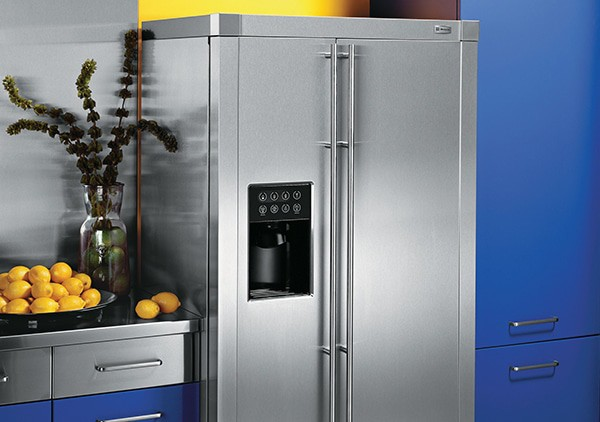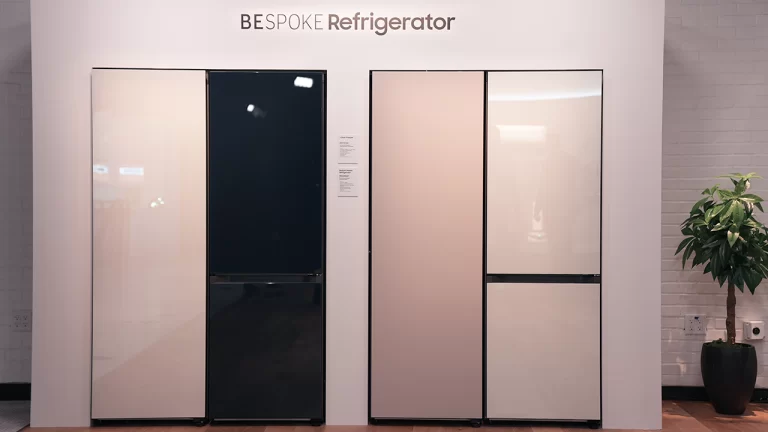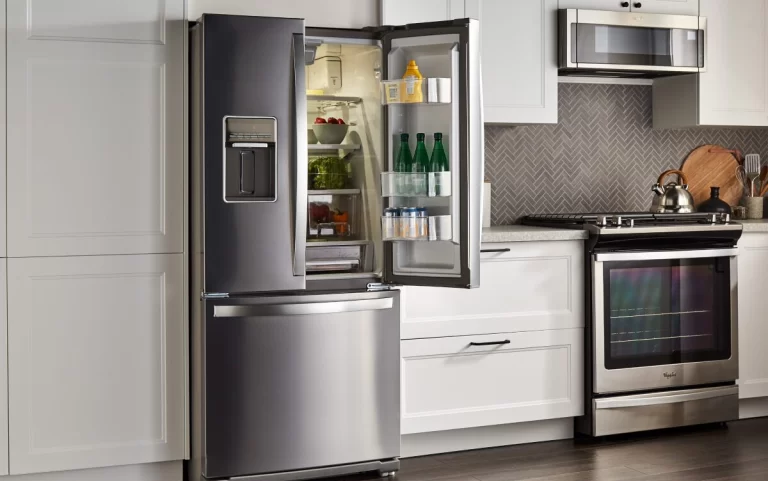Refrigerators are vital household appliances, and the GE Profile series stands out for its superior features and reliability. However, users occasionally face issues like GE Profile Refrigerator Not Cooling or Freezing. This problem can be a major inconvenience, but it’s not insurmountable. Our comprehensive guide aims to equip you with essential troubleshooting steps, routine maintenance advice, and insights into when professional intervention becomes necessary to handle this specific cooling and freezing issue effectively.
If your GE Profile Refrigerator isn’t cooling or freezing, check for common issues: incorrect thermostat settings, blocked vents, dirty condenser coils, worn-out door seals, malfunctioning cooling fan, refrigerant leaks, faulty control boards/sensors, overloading, or defrost system issues. If these don’t resolve the problem, consider professional assistance.
Quick Troubleshooting Guide
| Issue | Symptoms | Fix |
| Electrical Problems | Refrigerator not turning on | Check power outlet, circuit breaker, and power cord |
| Incorrect Thermostat Settings | Inadequate cooling or freezing | Adjust the temperature settings and give the refrigerator a few hours to reach the set temperature |
| Blocked Vents | Inefficient cooling or freezing | Regularly check the vents, rearrange items to allow for free movement of air |
| Dirty Condenser Coils | Refrigerator working harder, poor cooling | Clean condenser coils regularly |
| Worn-out Door Seals | Cold air escaping, poor cooling | Inspect seals for damage, replace if necessary |
| Malfunctioning Cooling Fan | Abnormal noises, inefficient cooling | Contact a professional for diagnosis and repair |
| Refrigerant Leaks | Excessive frost build-up, oil spots near the compressor | Contact a professional for diagnosis and repair |
| Faulty Control Boards and Sensors | Refrigerator not cooling or freezing properly | Contact a professional for diagnosis and repair |
| Blocked or Clogged Water Dispenser | Issues with cooling and freezing | Clean the dispenser or contact a professional for further assessment |
| Overloading the Refrigerator | Poor cooling and freezing | Ensure adequate space for air circulation |
| Issues with the Defrost System | Excessive frost build-up | Reset the refrigerator or contact a professional for diagnosis and repair |
| Inadequate Room Temperature | Refrigerator struggling to maintain desired temperature | Locate the refrigerator in a cool, dry place |
Understanding the Basics of Refrigerators
How Refrigerators Work – Refrigerators function by removing heat from the interior and releasing it outside. This is achieved through a cooling system comprising a compressor, condenser coils, evaporator coils, and refrigerant.
Special Features and Functions of GE Profile Refrigerator Series – GE Profile Refrigerators are known for their modern design, energy efficiency, and advanced features like customizable temperature settings, quick space shelves, and LED lighting.
The Importance of Proper Cooling and Freezing – Adequate cooling and freezing are essential for preserving food quality, preventing spoilage, and ensuring energy efficiency.
Common Causes for GE Profile Refrigerator Not Cooling or Freezing

1. Electrical and Refrigerator Power Issues
Issue:
A refrigerator that isn’t turning on or receiving power could be experiencing electrical problems. This could be due to various factors like a faulty power outlet, a tripped circuit breaker, or a defective power cord.
Fix:
- Firstly, ensure the refrigerator is properly plugged into the power outlet.
- Test the power outlet by plugging in another device to see if it works.
- Check the circuit breaker or fuse box in your home to make sure it hasn’t tripped or blown a fuse.
- Examine the power cord for any visible damages. If found, do not attempt to repair it yourself; instead, contact a professional service.
2. Thermostat Settings
Issue:
If the thermostat settings are incorrect, the refrigerator may not cool or freeze properly. Accidentally changing the temperature settings can lead to inadequate cooling.
Fix:
Check the temperature settings on your refrigerator’s control panel. The typical settings for the refrigerator should be between 35-38°F (2-3°C) and for the freezer at 0°F (-18°C).
If the temperature settings are incorrect, adjust them accordingly and give your refrigerator a few hours to reach the set temperature.
Read More: GE profile refrigerator ice maker reset
3. Blocked Vents
Issue:
The airflow inside the refrigerator and freezer is crucial for effective cooling. If the vents are blocked due to overloading or improper arrangement of food items, it could hinder the airflow and affect the cooling.
Fix:
Regularly check the vents inside the refrigerator and freezer to ensure they aren’t blocked by food items or containers.
Rearrange items if necessary to allow for free movement of air.
4. Dirty Condenser Coils
Issue:
The condenser coils dissipate heat from the refrigerator. If they’re dirty, they won’t dissipate heat effectively, causing the refrigerator to work harder and not cool properly.
Fix:
Regularly clean the condenser coils. Depending on the model of your GE Profile Refrigerator, the coils could be located at the back or bottom.
To clean, switch off and unplug your refrigerator. Use a coil brush or vacuum to remove the dust and debris. Plug the refrigerator back in once you’ve finished.
5. Worn-out Door Seals
Issue:
The door seals or gaskets ensure that the cold air stays inside the refrigerator. If they’re worn out or damaged, cold air will escape, affecting the cooling.
Fix:
Inspect the seals for any signs of damage or wear and tear, like cracks or looseness.
You can test the seals by closing the door on a piece of paper or a dollar bill. If the paper slides out easily, it’s likely that the seals need replacing.
Replace the seals or contact a professional if you’re unsure how to do this.
Check Out: GE profile arctica refrigerator problems
6. Malfunctioning Cooling Fan
Issue:
The cooling fan is responsible for circulating air inside the refrigerator. If the fan isn’t functioning correctly, it will impact the cooling and freezing.
Fix:
Listen for any abnormal noises coming from the refrigerator. If the fan is not working, it might make unusual noises.
If you suspect the cooling fan is malfunctioning, it’s best to contact a professional as this requires technical knowledge and experience.
7. Refrigerant Leaks
Issue:
Refrigerant is the substance that the refrigerator uses to remove heat from inside. A leak or low level of refrigerant can impact the refrigerator’s ability to cool.
Fix:
Signs of a refrigerant leak can include excessive frost build-up in the freezer or oil spots near the compressor.
If you suspect a refrigerant leak, contact a professional technician, as handling refrigerant requires specialized training and tools.
8. Faulty Control Boards and Sensors
Issue:
The control boards and sensors in your refrigerator help in regulating temperature and functioning. If they’re malfunctioning, your refrigerator may not cool or freeze as it should.
Fix:
This is a more complex issue that usually requires a professional technician.
If you have technical knowledge, you can open the back panel of your refrigerator to check for any visible damage or loose wires on the control board.
Generally, it’s recommended to contact a professional service to inspect and repair control boards and sensors.
Remember to always exercise caution when dealing with electrical appliances and contact a professional technician if you’re not comfortable or skilled in handling any of these issues.
9. Blocked or Clogged Water Dispenser
Issue:
A blocked or clogged water dispenser can lead to issues with cooling and freezing as it could be an indication of a problem with the refrigerator’s water system.
Fix:
Check the water dispenser for any visible clogs and clean it according to the manufacturer’s instructions.
If the dispenser is not clogged but still not working properly, it’s best to contact a professional for further assessment.
10. Overloading the Refrigerator
Issue:
Overloading the refrigerator can cause it to not cool or freeze properly. Too many items can block airflow and make the refrigerator work harder to maintain the set temperature.
Fix:
Ensure that your refrigerator is not overloaded. There should be enough space for air to circulate.
Arrange your items in such a way that there’s adequate space between them. Avoid stuffing the refrigerator and freezer compartments.
11. Issues with the Defrost System
Issue:
The defrost system in the GE Profile Refrigerator prevents it from icing up. If this system fails, it could cause the evaporator coils to freeze over, which could impact the cooling.
Fix:
If you notice excessive frost build-up in your freezer, it could be due to a faulty defrost system.
Resetting the refrigerator can sometimes fix minor glitches. However, for a potential defrost system problem, it’s safer to call in a professional technician.
Read More: GE refrigerator water dispenser not working but ice maker is
12. Inadequate Room Temperature
Issue:
The ambient room temperature can impact the cooling efficiency of the refrigerator. If it’s too high, the refrigerator may have trouble maintaining the desired internal temperature.
Fix:
Make sure your refrigerator is located in a cool, dry place, away from direct sunlight or heat-producing appliances.
If it’s in a warm location, you might want to consider moving it to a cooler spot if possible.
Every refrigerator problem may not have a DIY solution. Some may require professional assistance. If your GE Profile Refrigerator is not cooling or freezing, despite your troubleshooting efforts, it’s time to call a qualified appliance repair service. Keep in mind that trying to fix a complex problem yourself could potentially lead to further damage.
Step-by-Step Troubleshooting for Common Refrigerator Problems
Ensuring Power Supply and Proper Plug-in – Confirm that the refrigerator is securely plugged in and that the power outlet is functional.
How to Check and Adjust GE Profile Refrigerator Thermostat Settings – Use the control panel to review and adjust the temperature settings according to the user manual.
Clearing Blocked Vents for Better Airflow – Rearrange food and containers to make sure they are not blocking vents. Clean vents regularly to prevent dust build-up.
Assessing the Integrity of Door Seals and Gaskets – Use a dollar bill; place it so that it’s half inside and half outside the refrigerator. If it slips out easily when the door is closed, the seals may need replacement.
Evaluating the Refrigerator Cooling Fan – Listen for abnormal sounds and observe if the fan is running smoothly. Consult a technician if you suspect issues.
Identifying Signs of Refrigerant Leaks in GE Profile Refrigerators – If you notice excessive frost build-up or oily spots near the compressor, contact a professional to check for a refrigerant leak.
Inspecting Control Boards and Sensors – While this requires technical knowledge, check for any visible damage or loose wires. Consult a technician for an in-depth inspection.
When to Seek Professional Appliance Repair Service
Identifying Situations That Require a Professional Technician – When basic troubleshooting doesn’t resolve the issue, it’s time to contact a professional.
Tips for Choosing a Reliable Refrigerator Repair Service – Look for licensed professionals with good customer reviews, and ask for estimates and warranties on repairs.
Understanding the Average Cost of Common Refrigerator Repairs – Be aware that costs vary based on the problem and the parts needed. Typical repairs range from $100 to $400.
Navigating GE Profile Refrigerator Warranty and Support Options – Check if your refrigerator is still under warranty and understand the terms before seeking repairs.
Preventive Measures for Longevity and Energy Efficiency
Regular Cleaning and Maintenance Practices for Refrigerators – Clean the interior, exterior, coils, and vents regularly.
Tips for Efficient Usage to Reduce Wear and Tear – Avoid overloading, keep food properly sealed, and open doors minimally.
Understanding the Capacity Limits of GE Profile Refrigerators – Don’t overfill; allow space for air to circulate.
Thermostat Settings for Energy Efficiency – Keep the refrigerator between 35-38°F (2-3°C) and the freezer at 0°F (-18°C).
Importance of Timely Replacement of Worn-Out Seals and Gaskets – Regularly inspect and replace seals to ensure efficiency.
Regular Cleaning and Maintenance Practices for Refrigerators
Routine maintenance of your GE Profile Refrigerator can extend its lifespan, ensure efficiency, and prevent many cooling and freezing issues. Here are some fundamental practices to adopt:
Interior Cleaning: Keep the interior of your refrigerator clean to prevent odors and maintain hygiene. Regularly wipe down the shelves, drawers, and walls with a mild cleaner.
Exterior Cleaning: Wipe down the exterior with a damp cloth and mild soap. Don’t forget the handle and the top of the fridge, which can accumulate dust.
Condenser Coils: Clean the condenser coils every six months or as needed depending on your environment. Use a coil brush and vacuum to remove the dust and debris.
Door Seals or Gaskets: Inspect the door seals regularly for signs of wear and tear. A simple test to check their effectiveness is the dollar bill test. Close the door on a dollar bill and try pulling it out. If it slides out easily, it might be time to replace the seals.
Vents: Make sure the vents inside the refrigerator are not blocked by food items or containers. Blocked vents can hinder airflow and affect cooling efficiency.
Avoid Overloading: Overloading your refrigerator can block airflow and make your appliance work harder to maintain the set temperature. Leave some space between items to allow for free movement of air.
Remember, while regular maintenance can keep your refrigerator running optimally, certain problems may still occur and require professional assistance. For issues like a GE Profile Refrigerator not cooling or freezing, it’s recommended to seek professional help if the issue persists after troubleshooting.
Considering Alternatives and Responsible Disposal
When and Why to Consider Buying a New Refrigerator – If repairs are too costly or the unit is old and inefficient, it may be time to upgrade.
Energy-Efficient Alternatives to GE Profile Refrigerators – Research Energy Star-certified models for better efficiency and savings.
What to Look for in a New Refrigerator’s Features – Consider size, configuration, features, and energy efficiency.
Responsible Disposal of Old Refrigerators – Contact local waste management or recycling programs for safe disposal.
FAQs
What should I do if my GE Profile Refrigerator stops cooling or freezing despite following the troubleshooting steps?
If your GE Profile Refrigerator is still not cooling or freezing despite applying the troubleshooting steps mentioned, it’s likely that the issue is more complex and requires a professional’s expertise. You should contact a qualified appliance repair service. Remember to describe the problem and the steps you’ve taken to try to fix it. Additionally, check if your refrigerator is still under warranty as this could cover some or all of the repair costs.
How often should I clean the condenser coils of my GE Profile Refrigerator?
It’s recommended to clean the condenser coils every six months or as needed depending on your environment. If you have pets or if the refrigerator is located in a dusty area, you may need to clean them more frequently.
Is it normal for my refrigerator to run all the time?
Modern refrigerators like the GE Profile series are designed to run most of the time but they should cycle off occasionally. If you notice that your refrigerator is running constantly without cycling off, it could be a sign of a problem such as being set at too cold of a setting, being overfilled, or a door seal issue.
How do I know if my refrigerator’s door seals need replacing?
Check the integrity of the door seals by closing the door on a piece of paper or a dollar bill. If the paper slides out easily, it’s likely that the seals need replacing. Also, look for visual signs of wear or damage like cracks or loose spots.
What should I do if I suspect my GE Profile Refrigerator has a refrigerant leak?
If you suspect a refrigerant leak, it’s essential to contact a professional technician. Refrigerant handling requires specialized training and tools. Signs of a refrigerant leak can include excessive frost build-up in the freezer or oil spots near the compressor.
Additional Resources and Documentation
Conclusion
In conclusion, dealing with a “GE Profile Refrigerator Not Cooling or Freezing” problem may seem daunting, but it’s often something you can handle with the right guidance. From understanding the root causes to applying appropriate troubleshooting steps, and knowing when to call in professional help, this guide provides you with a well-rounded approach. Remember, consistent maintenance is key to extending the lifespan of your appliance and keeping it at optimal performance. With the information provided, you’re better equipped to keep your GE Profile Refrigerator running efficiently, ensuring your food stays fresh and safe.






